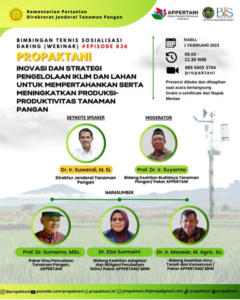#EPISODE 836 PROPAKTANI with APPERTANI Online Socialization Technical Assistance (WEBINAR)

CLIMATE AND LAND MANAGEMENT INOVATIONS AND STRATEGIES TO MAINTAIN AND INCREASE FOOD CROP PRODUCTION
By 2050, the world’s population is expected to increase by 2.4 billion people from current conditions, putting greater pressure on agricultural systems to maintain food security amid the threat of impacts of climate change (CC). APPERTANI in Webinar Episode 836 Propaktani raised the topic of innovation and strategies for managing agricultural resources, especially soil as a growing medium and climate is a physical environment that greatly affects growth, especially food crops. As the moderator of this episode of the webinar is Prof. Dr. Ir. Suyamto, APPERTANI Expert in the field of Food Crop Cultivation.
Dr. Elza Surmaini, APPERTANI-BRIN Expert with Expertise in CC Adaptation and Mitigation stated that the agricultural sector is in a position of contradiction between being vulnerable as a victim, and vice versa agricultural practices can contribute to the factors that drive the occurrence of CC. It is further elaborated that CC has a direct or indirect impact on the food crop sub-sector because it causes an increase in air temperature, changes in rain patterns, an increase in the frequency of extreme climate events and sea level rise. Climate information is key in addressing the impacts of CC to reduce the risk of yield loss and increase production. Climate predictions based on ENSO and Dipole Mode Index have been developed that can be utilized in agricultural planning. Innovative technologies to manage low rainfall that will have an impact on drought and high rainfall causing landslides and floods have been developed. The selection of innovations is recommended to pay attention to the characteristics of the region and the readiness of agricultural facilities and infrastructure. Adaptation can maintain resilience to CC to maintain food security and reduce GHG emissions while mitigating CC.
Climate change has an impact on crops and soils of food crop sub-sectors. Prof. Dr. Sumarno, M.Sc. Plant Breeder Expert of APPERTANI elaborated on efforts to provide and manage agricultural resources to increase food crop production in less climatic conditions, which include: (1) landforms on the earth’s surface; (2) water from various sources; (3) plant nutrients in the soil and from various sources; (4) species of plants, livestock, fish; (5) sunlight, temperature, wind air; (6) Oxygen, CO2; (7) plant varieties, seeds ; fertilizers and (8) soil and environmental biological systems. Agricultural is a biological industry based on the availability of natural resources. The availability of natural resources is not always reliable, limiting the amount of output. With the increasing impact of CC on agricultural enterprises, efforts to maintain agricultural life need to be intensified. Construction of water dams, village reservoirs or small-scale water dams, it is necessary for each village to manage water resources well.
Soils receive direct impacts from extreme climates, in the form of temperature changes, and salinity due to sea level rise. Climate change has biophysical impacts such as changes in land resources and salinity. Dr. Ir. Maswar, M. Agric.Sc. APPERTANI / BRIN Expert in Soil Science and Conservation Expertise provided material with the topic: Implementation of Soil and Water Conservation to Increase Production and Productivity of Food Crops in Less Conducive Climatic Conditions. Long-term high-intensity rainfall causes erosion and landslides with repercussions not only on the site but also on where the soil is deposited. Need for fertilization to restore the fertility of the affected soil. Panca Kelola Dry Land Technology consisting of: (1) water management, (2) nutrient management, (3) management of organic matter and amelioration, (4) soil conservation and (5) plant-livestock integration is recommended to be implemented to reduce yield gap and increase actual yields.


